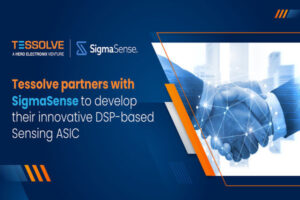Tessolve and SigmaSense have formed a strategic partnership to develop Tessolve’s novel DSP-based sensing ASIC. The state-of-the-art software-defined sensing technology from SigmaSense will be seamlessly merged with a cutting-edge, low-power touch-sense controller chip in this advanced mixed signal ASIC.
The chip’s revolutionary performance in terms of sensitivity, refresh rates, and signal-to-noise redefines touch and touchless interaction. It solves issues with high capacitive loads and slimmer displays, allowing accurate and continuous high-impedance sensing for a seamless user experience.
Offering SigmaSense customers unmatched sensitivity and ultra-low power consumption even under harsh environmental conditions, it boasts a broad range of applications spanning the automotive, gaming, consumer electronics, and computing sectors. It also has a unique digital signal processing system that improves programmability for the best possible user experience.
“Capitalizing on our expertise in pre-silicon design and post-silicon test, we developed the touch sense control solution, facilitating a smooth progression through the entire development process. This comprehensive approach effectively addresses the hurdles of conventional methods, resulting in faster time-to-market and enhanced quality for next-generation chip design,” Srini Chinamilli, Co-founder & CEO, Tessolve. “At Tessolve, we specialize in design and engineering services, with a focus on the seamless integration of various intellectual properties (IPs) into SOCs. Our primary focus behind this initiative was to prioritize stringent power demands through the integration of SigmaSense’s Analog IP and DSP IP into a powerful sensing SOC tailored for 40nm specifications.” he added.
Tessolve has developed its innovative product designs by utilizing cutting-edge sensing technology of SigmaSense. It successfully produced first-pass silicon by integrating the innovative Analog and Mixed Signal technology with speedy deployment of its IC Design and Methodology teams from RTL to GDS.
By offering complete ASIC services, including digital and analog design, post-silicon bring-up, and validation, Tessolve enhances time-to-market. Tessolve implemented a hybrid staffing model, combining onsite engineering in Austin with a larger team headquartered in Bengaluru, to optimize cost and time.
Tessolve accelerated ATE Test Development for a faster ramp to pro duction for the SDC300 by utilizing their test facility in Austin.
duction for the SDC300 by utilizing their test facility in Austin.
“Collaborating with Tessolve aligns with our vision of revolutionizing touch and sensing technology. Their expertise in silicon design and systems solutions was instrumental in bringing our innovative sensing ASIC to life,” Dave French, CEO, SigmaSense. “Our software-defined sensing technology brings superior sensitivity, low power consumption, and high performance to the product, across various applications. We are confident that this advanced microcontroller will have a significant impact in transforming user experiences in various sectors.”



